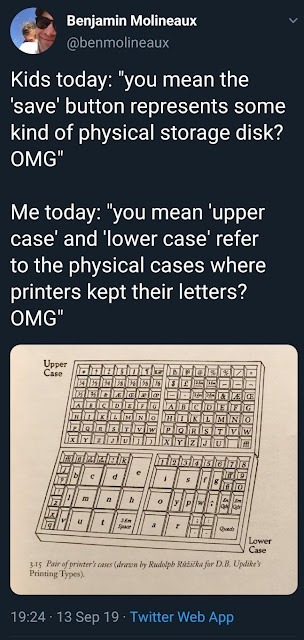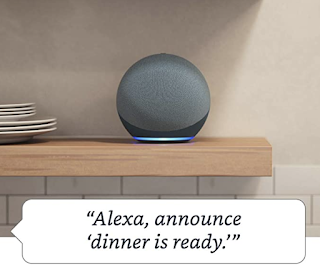Twitter made me laugh
This series of tweets was made into memes that circulate on Facebook. Every time these hit my feed, I get a chuckle. For the last 25+ years, I've been a graphic designer. Many of these interesting tidbits are things I already knew as part of the trade. However, now that I'm in this language arts class, the linguistics behind all of these memes struck me as interesting, yet again. I figured I'd share and add some of my own commentary.
Yes, letters used to be manually placed on the press for printing. The large letters, used less frequently, were stored above the press in the "upper case". The smaller letters, used more frequently, were stored in the lower case for easier access. (I did go through and double check some of the claims made in these memes for accuracy.)
No need to cite anything for this fact. We already learned, in class, that many words, in English, have French roots.
There are a lot of people with more knowledge than me that will argue about the 72 points in an inch line. There are very technical ways this has been calculated over the years and with different computer systems. I'm old-school graphic design. I was also originally trained at a newspaper. I don't think in terms of "inches" or "centimeters". Type-setters (old ones anyway) think in "picas". And yes, there are six picas in an inch and picas are broken into points. There are twelve points in a pica. Therefore - 72 points in an inch.
This meme was new information for me the first time I saw this series of tweets. I double checked it though, and it's true. Chiché is an onomatopoeic word that came from the sound of an old printing press. I find that both creative and hilarious.
I had to look up the word skeuomorphism. It means, in regards to digital technology, a design or design element, as an icon on a digital device, that mimics the three-dimensional look or the sound of a physical object. Examples beyond the naming of the "shift key" or the idea of "cut and paste" include seeing LCD hands on a smartwatch or the shutter sound on a digital camera.
I absolutely love paying attention to the words being used around me, now. As we become more and more digital, I wonder how long these older terms will stick around. Kids, these days, really don't know WHY we say we "hang up" the phone when we're done with a call. Watching technology change the world around me and watching language respond is just fascinating!
Works cited:
ALTA Language Services. “The Etymology of Clichés.” ALTA Language Services, 18 Feb. 2021, https://www.altalang.com/beyond-words/etymology-of-cliches/.
“Skeuomorph Definition & Meaning.” Dictionary.com, Dictionary.com, https://www.dictionary.com/browse/skeuomorph.
“Why Is It Called Upper and Lower Case?” Office for Science and Society, 10 May 2019, https://www.mcgill.ca/oss/article/did-you-know-history/why-it-called-upper-and-lower-case.








Comments
Post a Comment